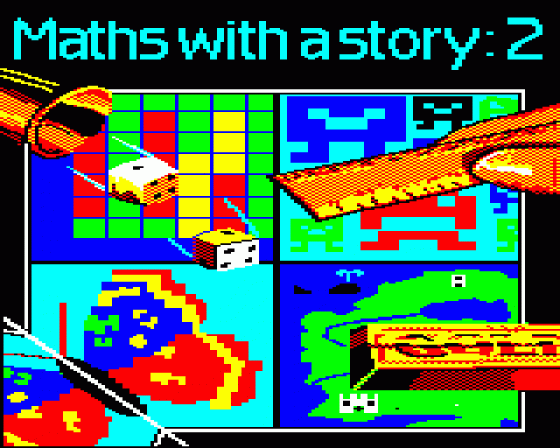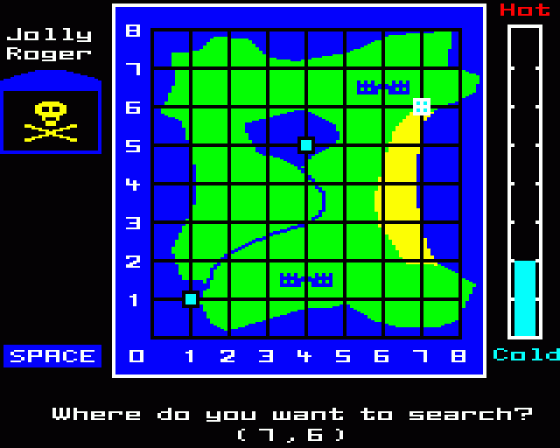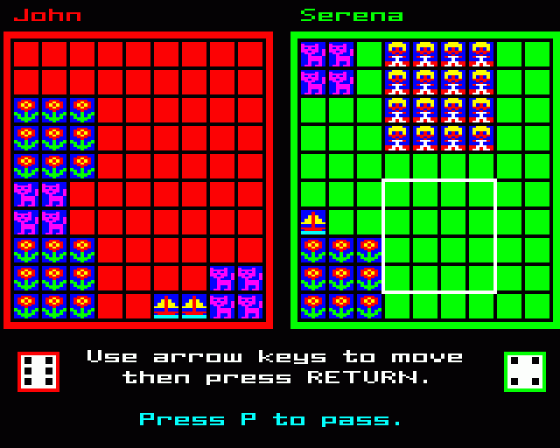
A&B Computing
 1st March 1986
1st March 1986
Categories: Review: Software
Author: Dave Reeder
Publisher: BBCSoft/BBC Publications
Machine: Acorn Electron
Published in A&B Computing 3.03
The four programs that make up this second pack present further mathematical ideas which are developed in the Schools Radio series, Maths With A Story. Although they complement these radio programmes, they can also stand alone and are aimed at home users as well as schools. They are produced on a cassette, with versions available for the BBC and Electron. The BBC version transfers to disc by means of the converter program, which is included at the end of the cassette.
This is a very friendly touch, which will be much appreciated by schools still using the data recorder to load their programs but hoping to purchase a disc drive and those, like myself, who object strongly to the software houses who "rip off" schools by adding several pounds for a disc version of a program. Surely it can't be that they're charging us for the extra time it takes to copy their protection!
As with Maths With A Story 1, the aim has been "to produce a range of mathematical activities which children will find fun and stimulating to use" and "designed so that the child, through participation, will learn and develop a range of mathematical skills ... and encourage children to develop problem-solving skills".

At this point it would be useful to refer you to my earlier review, because my general remarks are virtually the same. For the benefit of new readers who may not have a copy of that review, I think it's worth repeating some of the comments.
These programs are straightforward to use, one of the main ideas being that children should quickly learn the setting up procedures in order to use the software independently. The language used is as simple as possible, but the author has not shied away from introducing the correct mathematical words where appropriate. The well-illustrated handbook takes cognisance of the fact that parents have an important role to play in education and is full of suggestions and ideas - those worried about computers and mathematics will find this package a very useful starting point!
A great deal of thought has been put into the presentation of the programs - sound on/off; on-screen instructions (I particularly liked the lettering used) with a touch of the Space bar allowing you to work through the instructions at your own pace and the option of missing out on the instructions. The standard of screen design is very high and the activities themselves are well-structured to encourage children to employ logical reasoning to form strategies for success. If used in pairs or small groups, the programs are likely to stimulate valuable language work. Pirate Gold develops the concept of co-ordinates, which was introduced in Co-ordinate Jigsaw in the first pack. This is presented in a game format for one or two users who have to use co-ordinates to find the treasure chests. If instructions are requested, the computer will show how the program works and how to use the clues, i.e. the height/colour of the reading on the meter plus its movement, the colour of the square blob left behind on the grid and the tone of the sound - assuming the sound option has been taken. If you want to make it harder, you can choose not to use the meter!

There are lots of programs on the co-ordinates theme, but combining this with the development of logical thinking make this one of the most pleasing and practical for young children.
Turnflex also develops a concept introduced in Symmetry Patterns in the first pack by including the fact that an object and its reflection must be equidistant from the mirror surface. In the introduction option, the computer draws two pictures made up of six numerals, the right hand picture being a reflection of the left hand one. Press the Space Bar and the reflected picture disappears: the computer shows how to win back the number by correctly placing the mirror between the two tiles. When all the numerals have been won back, they have to be turned round until they make exact reflections of the picture.
The game itself is "for one player", although one "small group" is probably more appropriate if discussion on solving the problem set is to take place. The program offers the option of an 'easy' or 'hard' game. The former is like the introduction with the two square tiles always in line horizontally or vertically and each press on the Space bar turns the mirror through a right angle. In the more difficult option, the tiles may be placed diagonally from one another and the mirror only turns through half a right angle for each press on the Space bar.

Having explored the designs offered by the programs, you are then able to design your own pictures using the pixels in a combination of any two colours. This can provide a very useful introduction to Mode 7 graphics and teletext emulators - what a shame there's no option to save or print out any pleasing results!
The dice game on the first cassette was, in my opinion, the weakest of the four, but not so on this one. Dice Squares and in both games each player has his own grid. In the first game, having chosen the size of board, the dice are rolled (your own or the computer's) and, using the cursor keys, you place a horizontal row of that number of squares on the grid. The process continues until one of the boards is full. Infants enjoy matching the numbers on the dice with the pictures on the grid and are given useful practice in basic number combinations. Even at this level they can begin to develop some quite shrewd tactics.
Squares is played in the same way, except that each player fills a square instead of a row. In both games the option of renumbering the dice is offered, which can introduce some interesting possibilities. The programs could, I think, be usefully developed to give more options, e.g. size/shape of grid.

The last, but by no means least interesting program is The Tile Stretch Game - a game of strategy for one (against the computer) or two players. In fact, I think it's probably my favourite.
The board is a seven by six rectangle, and the basic tile covers one square. This can be stretched by up to three times in each direction and placed in a clear space on the board. Scoring is by points, e.g. a three by two stretch would give six points. The game ends when the board is filled up completely and the winner is the player with the highest score. Tactics required are similar to Squares, but this time, both players are using the same board, so not only are you trying to help yourself by your play but also make it more difficult for your opponent. As in Turnflex you can design your own tile, which is a pleasing touch. I can imagine this idea also being used effectively with children working on area and perimeter - which player can make the largest single shape?
I certainly think this set of programs is as good as, if not better than, the first. Is it too much to hope that we can look forward to numbers three, four and maybe more?
Other Reviews Of Maths With A Story 2 For The Acorn Electron
Maths With A Story 2 (BBC Soft)
A review by John Daddy (Electron User)


















